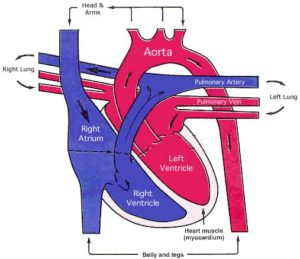Tetralogy of Fallot in Dogs & Cats
Tetralogy of Fallot is an uncommon congenital cardiac abnormality that can affect both cats and dogs. As the name indicates, animals with this condition have four characteristic heart defects. These defects are:
- Pulmonic Stenosis: this is a narrowing of the pulmonary artery as it exits the heart on its way to the lungs.
- Large interventricular communication
- Deviation of the origin of the aorta to the right
- Concentric right ventricular hypertrophy. The normal direction of blood flow is from the body > into the right atrium > to the right ventricle > through the pulmonary artery > to the lungs where the blood gets oxygen > back to the left atrium > to the right ventricle > and finally back to the aorta which takes the oxygenated blood back to the body.

The normal direction of blood flow is from the body > into the right atrium > to the right ventricle > through the pulmonary artery > to the lungs where the blood gets oxygen > back to the left atrium > to the right ventricle > and finally back to the aorta which takes the oxygenated blood back to the body.
In some cases of Tetralogy of Fallot, the pulmonic stenosis is so great, that the easiest path for the blood to take is from the right ventricle, through the hole in the septum to the left ventricle and out the aorta. This blood now on its way to the body has bypassed the lungs and is therefore unoxygenated. This causes a state of low oxygen throughout the animal’s body.
This congenital abnormality can occur in any breed and usually is detected at 2-8 months of age. Severely affected animals die at a very young age. Clinical signs can be highly varied. There can be no signs at all, dyspnea, exercise intolerance, less activity than previously or than a littermate. Cyanosis may culminate in a syncopal (fainting) episode.
Medical management to alleviate clinical signs includes:
- Phlebotomy: This is a procedure that removes some blood. This is done because the red blood cell count in this disease can be very elevated. The red blood cell count rises because the body senses the decrease in oxygen and more red blood cells are made in compensation. The resulting increase in red blood cells causes the blood to not flow well and actually clog smaller blood vessels.
- Hydroxyurea: This agent decreases the actual production of red blood cells by the marrow. Although surgical correction is performed in humans, it is not yet a practical treatment for animals. The objective of the surgery is to dilate the stenosis and to patch up the hole. An alternative surgery is to create a shunt from the aorta to the pulmonary artery.